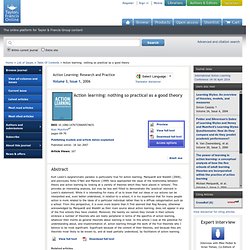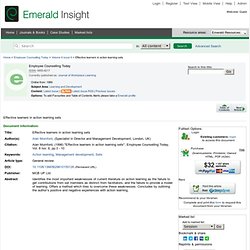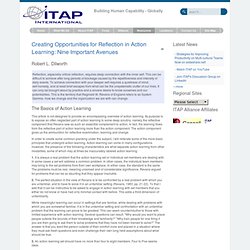

AL Chap Final Adams 5-3-09 _2_.doc. ABC-of-Action-Learning-CH1.
Action Learning in Practice. Four approaches to learning from experience. The International Foundation For Action Learning. A Review of Action Learning Literature 1994-2000 Part 1 – Bibliography and Comments Peter A.C.

Smith and Judy O’Neil As individuals, and in clusters and organizations, we are awash in assumptions. We presume validity at our peril in contexts that are increasingly complex and ambiguous. Professor Reg Revans originated action learning in its traditional generic form in the 1940’s as a means to improve UK coal production (Revans, R.W., Plans for Recruitment, Education and Training for the Coalmining Industry, Mining Association of Great Britain, London, 1945), and he later proposed the relationship L = P + Q to help better define action learning (Revans, R. A very wide variety of organizations now utilize action learning, and it gains ever widening application throughout the world. . ¨ Participants tackle real problems (no “‘right” answer) in real time ¨ Participants meet in small stable learning groups (called “Sets”) ¨ Each Set holds intermittent meetings over a fixed program cycle 1. 2. Action learning: nothing so practical as a good theory - 14767330600574631.
Action learning: nothing so practical as a good theory - Action Learning: Research and Practice - Volume 3. Kurt Lewin's epigrammatic paradox is particularly true for action learning.

Marquardt and Waddill (2004), and previously Yorks O'Neil and Marsick (1999) have approached the issue of the relationship between theory and action learning by looking at a variety of theories which they have placed in ‘schools’. This provides an interesting analysis, but may be less well fitted to demonstrate the ‘practical’ element in Lewin's statement. While it is interesting for many of us to know that our ideas or our actions can be interpreted and, even better understood, in relation to a school, it is my experience that for many people action is more related to the ideas of a particular individual rather than to a diffuse categorisation such as a school. From this perspective, it is even more bizarre than it first seemed that Reg Revans, otherwise acknowledged by Marquardt and Waddill as their main source about action learning, does not appear in any of the five schools they have created.
Effective learners in action learning sets. [Jump to content] Your account: Welcome: Guest Browse Emerald Insight: Resource areas:

Learning in action. The Role of Questions in Teaching, Thinking and Le. One of the reasons that instructors tend to overemphasize "coverage" over "engaged thinking" is that they assume that answers can be taught separate from questions.

Indeed, so buried are questions in established instruction that the fact that all assertions-all statements that this or that is so-are implicit answers to questions is virtually never recognized. For example, the statement that water boils at 100 degrees centigrade is an answer to the question "At what temperature centigrade does water boil? ". Hence every declarative statement in the textbook is an answer to a question. Hence, every textbook could be rewritten in the interrogative mode by translating every statement into a question. To my knowledge this has never been done. Thinking is Driven by Questions But thinking is not driven by answers but by questions. Questions define tasks, express problems and delineate issues. The Role of Socratic Questioning in Thinking, Teac. One of the reasons that instructors tend to overemphasize “coverage” over “engaged thinking” is that they do not fully appreciate the role of questions in teaching content.

Consequently, they assume that answers can be taught separate from questions. Indeed, so buried are questions in established instruction that the fact that all assertions — all statements that this or that is so — are implicit answers to questions is virtually never recognized. For example, the statement that water boils at 100 degrees centigrade is an answer to the question “At what temperature centigrade does water boil?”
Hence every declarative statement in the textbook is an answer to a question. Hence, every textbook could be rewritten in the interrogative mode by translating every statement into a question.
Creating Opportunities for Reflection in Action Learning: Nine Important Avenues. Robert L.

Dilworth The Basics of Action Learning This article is not designed to provide an encompassing overview of action learning. Its purpose is to expose an often neglected part of action learning to some deep scrutiny, namely the reflective component that Revans saw as such an essential complement to action. In fact, the learning flows from the reflective part of action learning more than the action component. In order to create some common planking under the subject, I will reiterate some of the more basic principles that undergird action learning. 1. 2.
While meaningful learning can occur in settings that are familiar, while dealing with problems with which you are somewhat familiar, it is in the unfamiliar setting and confrontation with an unfamiliar problem that the learning can prove to be greatest. 3. 4. 5. 6. There can be more controversy around the role of a facilitator than any other area related to action learning. 7.
The Nature of Reflection 1. 2. A.
The Practical Primacy of Questions in AL.